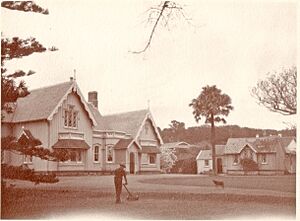Highwic facts for kids
Quick facts for kids Highwic |
|
|---|---|
 |
|
| General information | |
| Status | Historic house museum |
| Architectural style | Carpenter Gothic |
| Address | 40 Gillies Avenue, Epsom (off Mortimer Pass Newmarket) |
| Country | New Zealand |
| Coordinates | 36°52′18″S 174°46′30″E / 36.8718°S 174.7749°E |
| Opened | 1981 |
| Designated: | 7 April 1983 |
| Reference #: | 18 |
Highwic is a historic house in Auckland, New Zealand. It was built in the 1800s and is now a museum. Heritage New Zealand lists it as a very important building.
The house was built in 1862 for Alfred Buckland. He was a rich settler and landowner. Highwic sits on a hill, looking over the area of Newmarket.
Contents
Building Highwic
Highwic is a large house built in a style called Carpenter Gothic. This style uses wood to create designs often seen in stone buildings. Alfred Buckland, a wealthy landowner, had it built.
In 1861, Alfred's first wife, Eliza, bought the land for £1,000. The family, with seven children, moved into the house in 1862. Eliza had two more children while living there. She sadly passed away in 1866.
The house started with eight rooms. As the Buckland family grew and became richer, they added more rooms. Extensions were built in 1874, 1883, and 1884.
Alfred Buckland married Matilda Jane Frodsham in 1867. Matilda was much younger than Alfred. She had eleven children, and nine of them lived to be adults. Matilda lived at Highwic even after Alfred passed away.
The house had many rooms, including a drawing room and several bedrooms. There was also a boys' dormitory, a laundry, kitchen, and a scullery. Outside, there were stables and rooms for the grooms. A billiard house and a service yard were also part of the property.
In the early 1900s, two bathrooms were added inside the house. These had baths, sinks, flushing toilets, and hot and cold water. The Buckland family lived in the house until 1978. They made some changes to it over the years.
To save Highwic from being divided up, Heritage New Zealand (then called the New Zealand Historic Places Trust) and Auckland City Council bought it together. Highwic opened as a historic house museum in 1981.
Events and Celebrations
Highwic has hosted many special events over the years. In 1980, a party was held there for the Duke of Kent and Katharine, Duchess of Kent. In 1982, a big ball was held to help the New Zealand Blood Foundation. This event was even featured in a magazine.
The Twelve Days of Christmas
In 1985, Highwic held a special exhibition called "The Twelve Days of Christmas". It showed many Christmas items. These included decorations, cards, and Christmas trees. There was also carol singing and beautiful flower displays. Old dolls and toys were on display too.
The exhibition also explained Christmas stories and symbols. Visitors could buy gifts at a shop. One of the large Norfolk Island Pine trees outside was decorated with 800 lights. Sometimes, rooms inside the house were lit only by candles.
150th Anniversary
In 2012, Highwic celebrated its 150th birthday with events all year long. People could enjoy high tea at the house. There was also a collection of Victorian-era costumes and flowers as part of the Festival of Flowers. Music and art events were also held.
Highwic was a main attraction during the Auckland Heritage Festival that year. A concert called A Song Without Words took place in the ballroom. It celebrated the music of students of Felix Mendelssohn.
Filming Location
Highwic has been used as a setting for many films and TV shows. Music artists like Bic Runga and Rhys Darby have filmed there. Television shows such as The Jono Project and The Luminaries have also used the house.
Ghost Stories
Some people believe Highwic is one of the most haunted places in Auckland. There are stories of a ghost being seen in one of the bedrooms. It is also said that a ghostly dog lives there. A former spokesperson once claimed to have seen a black dog running across the garden. These are just stories that add to the mystery of the old house.


